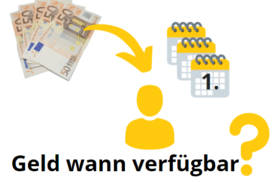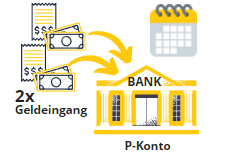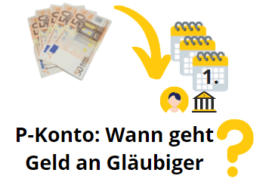You have already paid your garnishment in full. This is an important step. However, once you have paid the garnishment, the question arises as to when the account will be fully usable again. In fact, this question is not so easy to answer and also depends on the bank that manages your account.
through the Opening of a P-Konto you can protect yourself from garnishment and secure your survival and some social participation through protected allowances. You can set up a P-Konto retroactively to the first of the month. However, the conversion to a P-Konto must be done before 4 weeks have passed since the garnishment. Even a precautionary conversion before the garnishment order comes is possible.
Garnishment paid: When the account becomes free again depends on three factors or rules
The garnishment is paid, but when will the account be free again? - That depends on the bank, repayment method and the completeness of the payment.
When the Account after paid garnishment is free again depends on whether and when you have repaid the debt in full (1), which bank you are with (2) and how you proceed in repaying the debt (3).
1. the account is not free again until all debts have been fully repaid
In general, it is the case with all banks that the account garnishment continues until the debts are repaid in full. are. If the claim is paid directly from the account balance, the garnishment ends. However, if there is not enough money in the account to pay the garnishment in one go, the account garnishment may drag on for several months.
2. garnishment paid: When the account is free again also depends on the bank
This article summarizes the statements of several banks explaining how to handle the account after the garnishment has been paid. When the garnishment is paid, the banks give different answers to the question "When will the account be free again?". The more digitalized the bank is, the faster it usually goes. At Commerzbank, for example, it takes only one to two days to activate the account. Other banks often need about a week to activate the account after the creditor's confirmation has been received.
As a debtor concerned, you should definitely know when the account is free again after paid garnishment at your bank.
Regarding the question "Garnishment paid: When will the account be free again?", I have found at:
once looked to see what the banks think about it.
3. when the account is free again depends also on how you pay off the debts
There are two different ways you can pay a garnishment to free up your account:
- You handle the payment of debts through a Bank transfer set in parallel. In this case, since the bank does not know that the creditors have already been satisfied, the account is not released immediately after the transfer. Instead, the creditors must first send a cancellation of the garnishment to the bank (as confirmation).
- You take care of the payment of debts by an instruction to the bank to pay the debts to the creditors to pay. Many banks provide you with a form for this in online banking. Since the creditor satisfaction runs through the bank directly, no more inquiries with the creditors are necessary. This way is much faster and therefore better if the account should be free again quickly after the garnishment has been paid.
In the event that you cannot pay the garnishment immediately, be sure to convert your account to a P account convert or create a new Open P account. This is the only way to ensure that you have a balance left in the account to survive.

What you can learn here
- Garnishment paid: When the account becomes free again depends on three factors or rules
- Garnishment paid, when is the account free again?
- If the garnishment is not yet paid, the account is also not free
- If the garnishment has already been paid:
- Conclusion: When is the account free again when the garnishment is paid?

Garnishment paid, when is the account free again?
This section deals with the different ways in which banks handle the question of when the account is free again once the garnishment has been paid.
Savings Bank
The Sparkasse is vague on its official website regarding an exact date when the account will be free again. Thus, the Sparkasse only states on the topic "Garnishment paid, when is the account free again?
"In the case of a garnishment, an account is not unblocked until the outstanding debts that led to the garnishment have been paid."
Source [1]: Savings bank website
The Sparkasse Karlsruhe expresses itself only little more concretely to the time, when the account is again free after paid seizing. Thus it is called with the Savings Bank Karlsruhe [2]that the account could only be unblocked by immediate payment of the garnishment.
Commerzbank
Commerzbank writes on its website:
"The blocking of your accounts will be lifted again when you pay the creditor the full amount of the garnishment or the creditor informs us in writing that the garnishment has been lifted."[...] The processing takes a few days."
Source [3.1, 3.2]: Commerzbank website
Commerzbank customers who already had a garnishment on their account report that it took two to three days until the account was free again after the garnishment had been paid.
People's Bank
The Volksbank does not comment specifically on how long it takes to lift the account block after the garnishment has been paid. However, there is a general pamphlet on the subject of account garnishment, in which it is pointed out that the garnishment covers all future money entries until a full repayment of the debt has been made.
"The garnishment affects future cash receipts in addition to the current balance. We will inform you of the garnishment and send you a notice with a payment order."
Source [4]: Website of Volksbank Mittelhessen
The credit union provides several options for paying off debts in the event of account garnishment.
It can be assumed, as with other banks, that the Volksbank account will be freed up most quickly if the garnishment is paid via online banking. This way you can pay your garnishment when you want to fully use your Volksbank account again:
"You can submit the payment order sent to you by mail, fax or at a branch. You can also find a corresponding service order for payment in online banking and the VR Banking app under the Service tab. The processing and execution of the prepared payment order will be done at no additional cost to you."
Source [4]: Website of Volksbank Mittelhessen
postal bank
Postbank only gives a general statement on the procedure of the garnishment. Postbank states that it is obliged to transfer the existing credit balance to the creditor.
In addition, Postbank provides information on the existing Debtor protection period of one month from service of the garnishment order. Within this protection period, Postbank (like other banks) shall not yet make any transfer to the creditor.
Subsequently, the garnishment will be effected in full or in part. In the event of partial payments, the Postbank account shall remain blocked until the debts have been fully repaid. After the garnishment has been paid in full, the Postbank account will be released again.
Postbank further elaborates on the duration of the garnishment in case of a P-Konto:
"If your attached checking account is a P-Konto, Postbank will dispose of the credit balance or incoming payments against your garnishment allowance and - provided the Allowance not exceeded due to receipt of payment will make it available to you on the same day after it has been credited. Please note that Postbank - especially at peak times (e.g. change of month) - has to schedule a very large number of payments."
Source [5]: Postbank website
The offsetting of the cash receipt against the P-Konto Allowance is therefore usually done on the same day at Postbank. At the turn of the month, however, the release of the money may be slightly delayed, as many orders are received then.
This statement gives an indirect answer to the question about the duration of the account release after paid garnishment. Because you can deduce from this that the account release at the Postbank probably does not take longer than two or three bank working days. Provided that the debts have been completely repaid and you have informed the Postbank about a complete debt repayment.
German Bank
Let's look at Deutsche Bank next. When will Deutsche Bank release the account after the garnishment has been paid? Deutsche Bank comments on this as follows:
"Deutsche Bank must then transfer the pledge amount from your account balance to the pledgee (Note: After the 4-week debtor protection period has expired). If the transfer is delayed, only the future balance on the Pfändungsschutzkonto is protected."
Source [6]: Deutsche Bank website
Deutsche Bank therefore does not specify an exact duration. However, Deutsche Bank is generally not very digitized and much is still done by mail or telephone. Setting up a P-Konto is also only done via a conversation with the bank. This is an indication that account approval at Deutsche Bank could take longer
A forum user confirms the assumption and writes about the release of the account after settled garnishment, that 10-12 bank working days pass until the account at Deutsche Bank would be released.
After all, Deutsche Bank confirms a little later in the text that the garnishment has been settled after all debts have been repaid. So says the bank:
"If you do not need garnishment protection or want to settle the debt, the garnishment process would be completed when you remit the full garnishment amount."
Source [6]: Deutsche Bank website
Targobank
In order to lift the garnishment at Targobank, one finds online the indication that Targobank has an open ear for the lifting of the account block. This is what it says:
"There are several reasons why an account or card may be blocked. Is there possibly a garnishment? Does the current paycheck still fit the overdraft limit? Let's keep an eye on it together and discuss the possible reason."
Source [7]: Targobank website
Unfortunately, Targobank did not publish any information on the specific duration for lifting the garnishment. It is therefore advisable that you contact your Targobank contact person immediately after receiving the garnishment order and discuss the procedure for paying the garnishment.
norisbank
norisbank reminds its customers once again that the subsistence level is not protected in the event of an attachment. Therefore, the bank immediately advises to set up a P-Konto as well as legal assistance by a lawyer or a debt counseling center. This is what norisbank says:
"At the same time, there is initially no automatic protection of the subsistence level. This means that you may no longer be able to meet your payment obligations (e.g. rent or energy supplier). Therefore, you should immediately have your Girokonto converted to a "Pfändungsschutzkonto" (P-Konto). This way, you will at least have a certain basic amount each month that cannot be seized.
Source [8]: norisbank website
After that, you should visit your attorney or a debt counseling agency to find out how to proceed."
Unfortunately, norisbank did not publish any exact information on the specific duration of the lifting of the garnishment. However, one can find a complaint of a norisbank customer online, [9] which denounces that the norisbank account was still not free even 3 days after the confirmation by the creditor.
In defense of norisbank, it must be said that the bank received confirmation from the creditor that the debt had been repaid around the turn of the month. This is the time when the banks receive the most orders and therefore there may be a short overload and a short waiting time.
If the garnishment is not yet paid, the account is also not free
In order to speed up the process of account activation, it helps to contact your bank. During the conversation you can ask about the payment options for the garnishment and the subsequent activation of the account. In most cases, the quickest way to activate the account is to instruct the bank to make a manual transfer to the creditor.
As soon as the transfer has been successfully executed, the bank will activate the account again. You should not wait long to contact the bank in the event of a garnishment, because time is short. If possible, it is advisable to contact the bank outside of the monthly period.
ImportantIf you make the payment to the creditor yourself in parallel, a certificate from the court of execution or the tax office (if it is a debt of the tax office) is necessary. Since creditors often take a few days to issue the certificate, it takes longer to lift the freeze.

If the garnishment has already been paid:
The bank must lift an account garnishment when the debts have been paid off. If all debts can be paid directly from the account, the garnishment ends.
In the event of a garnishment, it is best to contact the bank directly. After all, concrete statements from the bank have the greatest significance. A short conversation will tell you for sure when the account will be free again.
Conclusion: When is the account free again when the garnishment is paid?
Regardless of whether it's a savings bank, Volksbank, Postbank, Deutsche Bank, Targobank or other banks: direct and personal inquiries with your bank will always help you the most.
The processing times in individual cases can only be generalized approximately. For example, at banks with advanced digitization, such as Commerzbank or ING, the account can usually be activated in one to two days. Other banks, such as Deutsche Bank, often need more like a week for activation. The times given refer to the point in time when the bank receives confirmation from the creditor that the payment has been made.
However, when the account is free again after the garnishment has been paid also depends on whether:
- You have paid the debt in full
- You have settled the debt directly through a fornular (often through online banking) or through parallel means.
Direct settlement of debts is recommended and eliminates the need for proof of payment from the creditor. Therefore, this way is also often much faster.
Sources
[1] Savings Bank website. Link: https://www.sparkasse.de/unsere-loesungen/privatkunden/rund-ums-konto/girokonto/kontosperrung.html
[2] Website of the Sparkasse Karlsruhe. Link: https://www.sparkasse-karlsruhe.de/de/home/privatkunden/girokonto/information-pfaendungen.html
[3.1] Commerzbank website. Link: https://service.commerzbank.de/was-passiert-wenn-mein-konto-gepfaendet-wird/
[3.2] Commerzbank website. Link: https://service.commerzbank.de/wie-begleiche-ich-eine-kontopfaendung/
[4] Volksbank Mittelhessen website. Link: https://www.vb-mittelhessen.de/content/dam/f0603-0/Downloads/Service/formulare_von_a_bis_z/volksbank-mittelhessen-pfaendungen-wichtige-fragen-und-antworten-VBMH26805.pdf
[5] Postbank website. Link: https://www.postbank.de/privatkunden/services/kundenservice/pfaendungsschutzkonto.html
[6] Deutsche Bank website. Link: https://www.deutsche-bank.de/pk/service-und-kontakt/weitere-themen-und-kooperationen/pfaendungsschutzkonto.html
[7] Targobank website. Link: https://www.targobank.de/de/service/forderungsmanagement.html
[8] norisbank website. Link: https://www.norisbank.de/service/kontakt-und-wissen/finanzwissen/girokonto-gesperrt-was-tun.html
[9] Website of reklamation24 on the topic: When is the norisbank account free again after paid garnishment. Link: https://www.reklamation24.de/norisbank/aufhebung-von-pfandung-112590














I have paid my debts directly to the creditor who has informed the Postbank on 06.01.2023 by fax and by letter that the debt has been repaid in full.
Until today 07.02.2023 Postbank was not able to take the garnishment from the account. Thus, the Postbank needs neither days nor a week, but more than 4 weeks. No end in sight
This is really annoying and hopefully only an isolated case. Thank you for describing your experience on KKV.